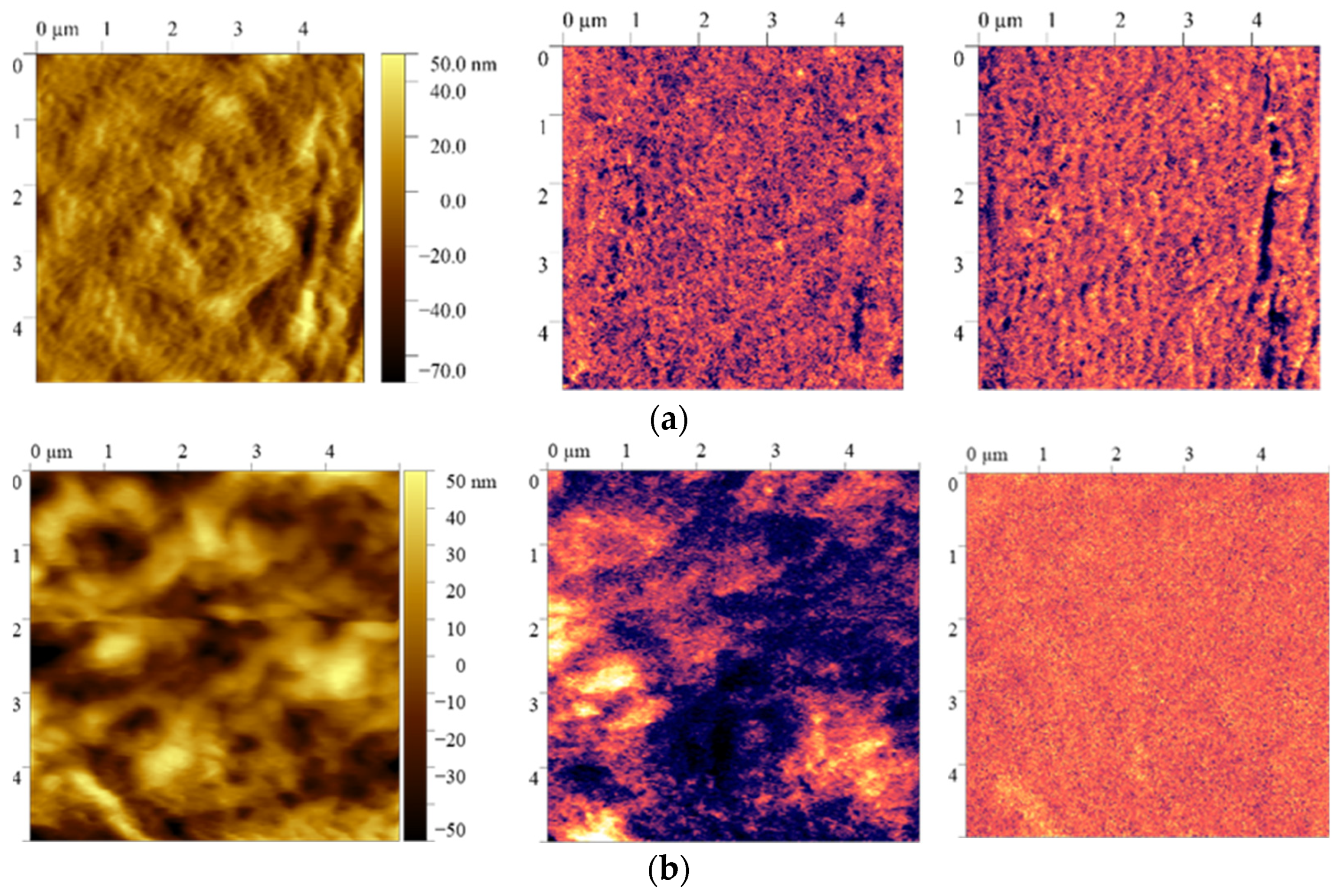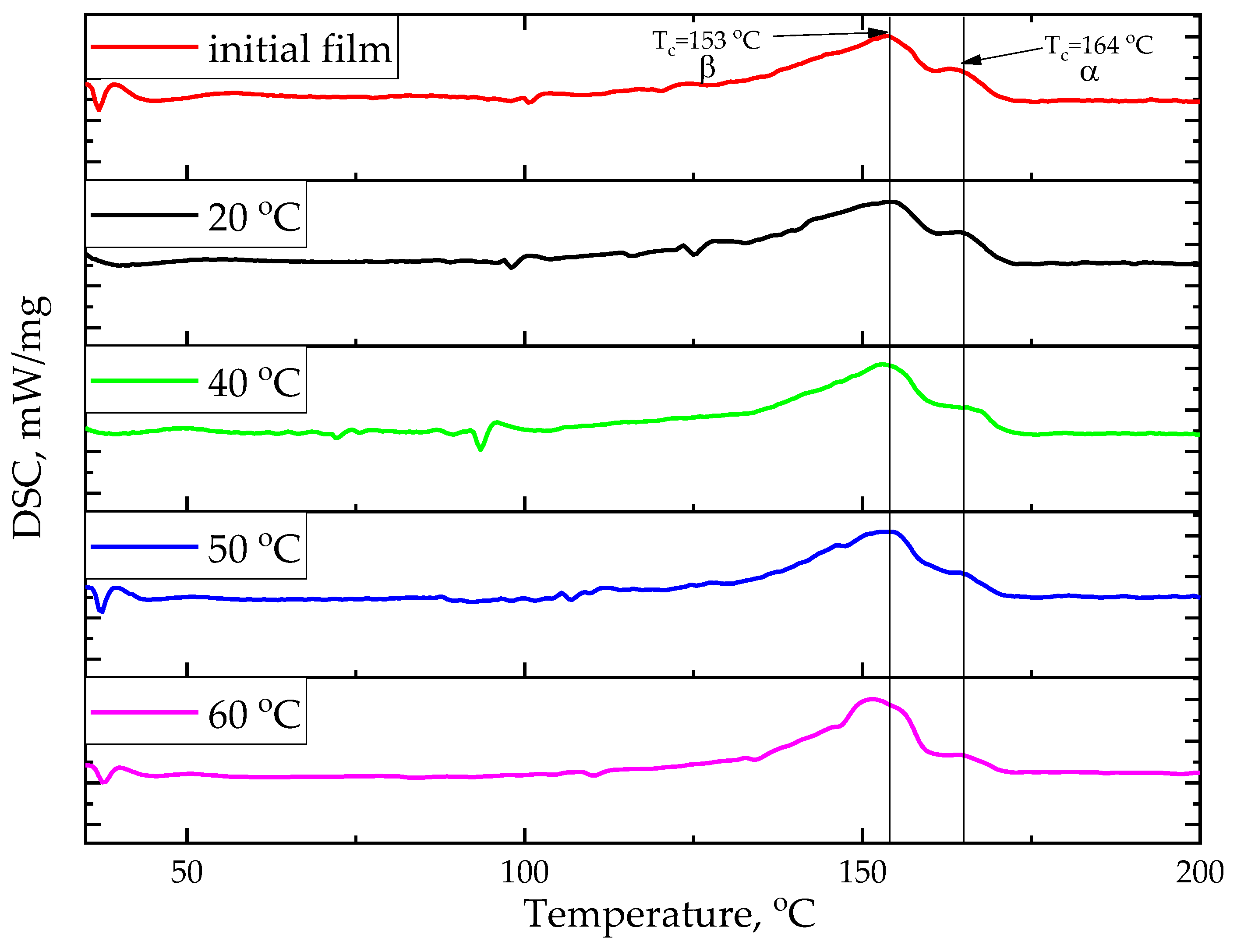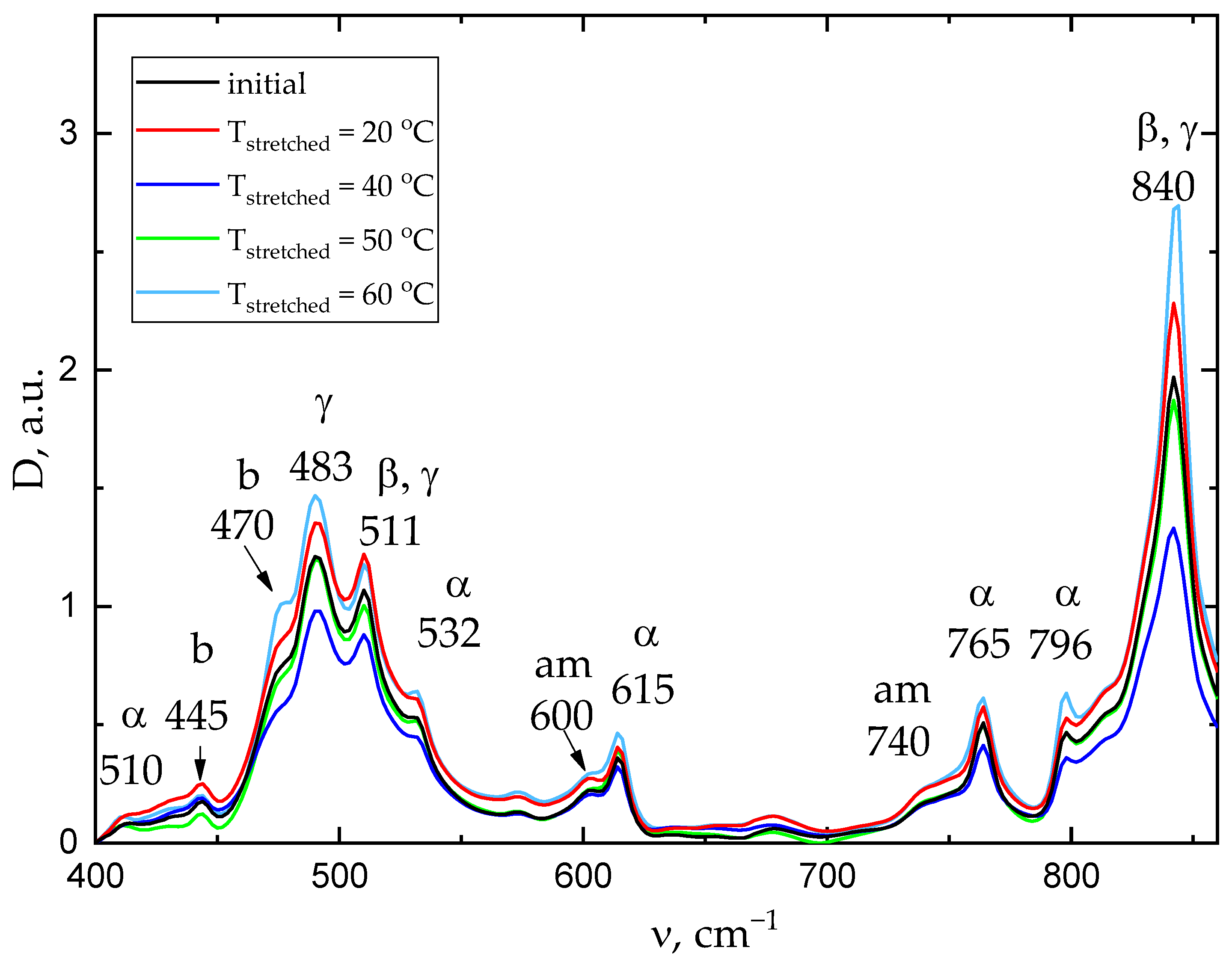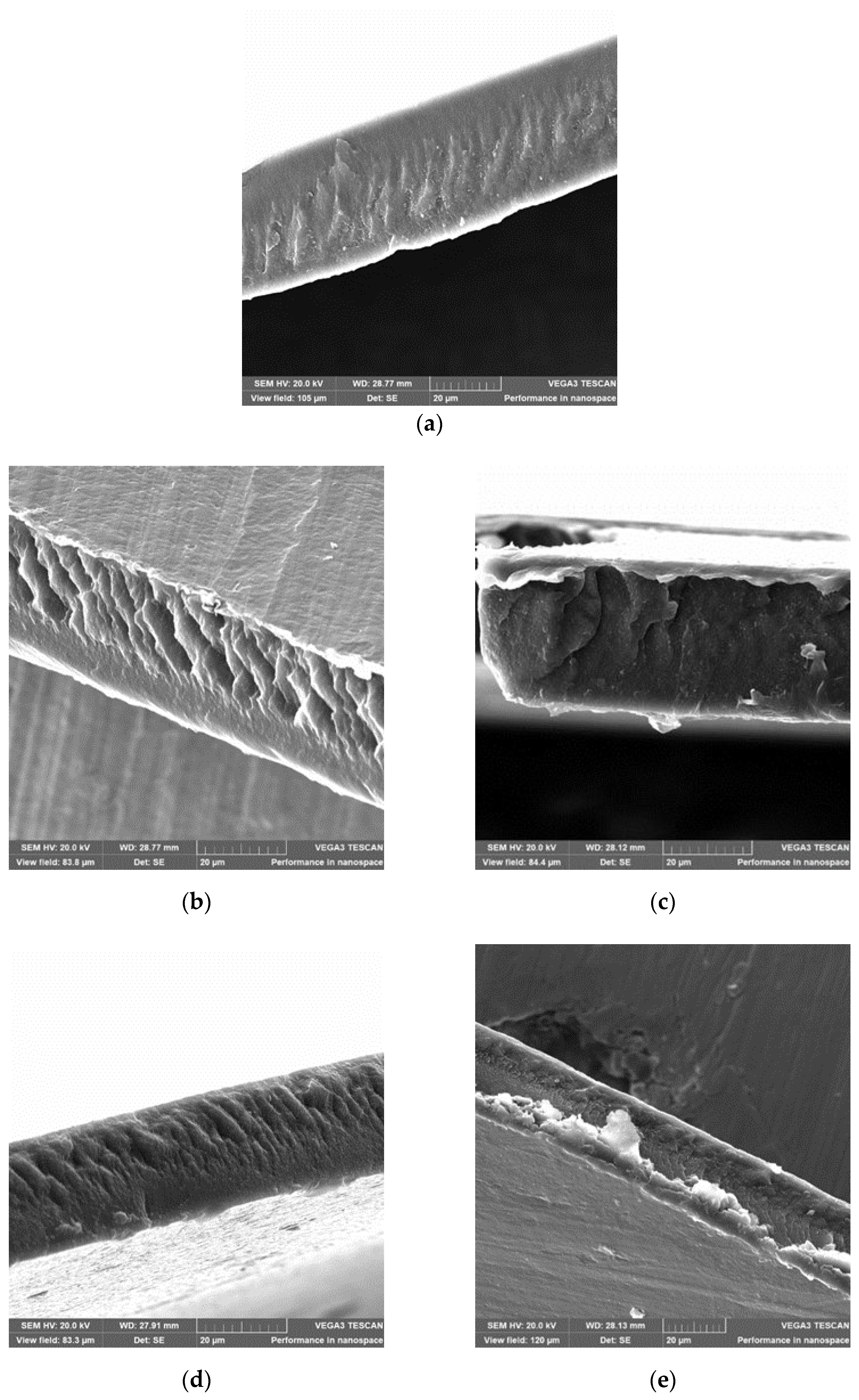Low-Temperature Uniaxial Orientation Effect on the Structure and Piezoelectric Properties of the Vinylidene Fluoride-Tetrafluoroethylene Copolymer Films
Abstract
1. Introduction
2. Results
2.1. Electrical Strength Research
2.2. Contact Polarization (Measuring the Macroscopic Piezoelectric Coefficients by the Berlincourt Method)
2.3. Piezoresponse Force Microscopy
2.4. Differential Scanning Calorimetry
2.5. IR Fourier Spectroscopy
2.6. Density Measurement by the Hydrostatic Weighing Method
2.7. Scanning Electron Microscopy
3. Discussion
4. Materials and Methods
4.1. Uniaxial Stretching Technique
4.2. Contact Polarization
4.3. Research Methods
4.3.1. Macroscopic Piezoelectric Coefficient d33 Measurement
4.3.2. Electrical Strength Measurement
4.3.3. Piezoresponse Force Microscopy
4.3.4. Scanning Electron Microscopy
4.3.5. Differential Scanning Calorimetry
4.3.6. Fourier Transform Infrared Spectroscopy and Computation Based on It
4.3.7. Density Measurement by the Hydrostatic Weighing
5. Conclusions
Author Contributions
Funding
Institutional Review Board Statement
Informed Consent Statement
Data Availability Statement
Acknowledgments
Conflicts of Interest
References
- Kochervinskii, V.V.; Gradov, O.V.; Gradova, M.A. Fluorine-containing ferroelectric polymers: Applications in engineering and biomedicine. Russ. Chem. Rev. 2022, 91, RCR5037. [Google Scholar] [CrossRef]
- Andrey, V.; Koshevaya, E.; Mstislav, M.; Parfait, K. Piezoelectric PVDF and its copolymers in biomedicine: Innovations and applications. Biomater. Sci. 2024, 12, 5164–5185. [Google Scholar] [CrossRef] [PubMed]
- Liu, G.; Zhang, S.; Jiang, W.; Cao, W. Losses in ferroelectric materials. Mater. Sci. Eng. R Rep. 2015, 89, 1–48. [Google Scholar] [CrossRef] [PubMed]
- Kochervinskii, V.V.; Gradova, M.A.; Gradov, O.V.; Kiselev, D.A.; Ilina, T.S.; Kozlova, N.V.; Shmakova, N.A.; Kalabukhova, A.V.; Bedin, S.A. Structural, optical, and electrical properties of ferroelectric copolymer of vinylidenefluoride doped with Rhodamine 6G dye. J. Appl. Phys. 2019, 125, 044103. [Google Scholar] [CrossRef]
- Kochervinskii, V.V.; Buryanskaya, E.L.; Makeev, M.O.; Mikhalev, P.A.; Kiselev, D.A.; Ilina, T.S.; Lokshin, B.V.; Zvyagina, A.I.; Kirakosyan, G.A. Effect of Composition and Surface Microstructure in Self-Polarized Ferroelectric Polymer Films on the Magnitude of the Surface Potential. Nanomaterials 2023, 13, 2851. [Google Scholar] [CrossRef]
- Harris, G.R.; Howard, S.M.; Hurrell, A.M.; Lewin, P.A.; Schafer, M.E.; Wear, K.A.; Zeqiri, B. Hydrophone measurements for biomedical ultrasound applications: A review. IEEE Trans. Ultrason. Ferroelectr. Freq. Control 2022, 70, 85–100. [Google Scholar] [CrossRef]
- Xin, Y.; Sun, H.; Tian, H.; Guo, C.; Li, X.; Wang, S.; Wang, C. The use of polyvinylidene fluoride (PVDF) films as sensors for vibration measurement: A brief review. Ferroelectrics 2016, 502, 28–42. [Google Scholar] [CrossRef]
- O’Reilly, M.A.; Hynynen, K.A. PVDF receiver for ultrasound monitoring of transcranial focused ultrasound therapy. IEEE Trans. Biomed. Eng. 2010, 57, 2286–2294. [Google Scholar] [CrossRef]
- Lin, Y.; O’Reilly, M.A.; Hynynen, K.A. PVDF Receiver for Acoustic Monitoring of Microbubble-Mediated Ultrasound Brain Therapy. Sensors 2023, 23, 1369. [Google Scholar] [CrossRef]
- Kharat, D.; Mitra, S.; Akhtar, S.; Kumar, V. Polymeric Piezoelectric Transducers for Hydrophone Applications. Def. Sci. J. 2007, 57, 7–22. [Google Scholar] [CrossRef]
- Sessler, G.M. Piezoelectricity in polyvinylidenefluoride. J. Acoust. Soc. Am. 1981, 70, 1596–1608. [Google Scholar] [CrossRef]
- Saxena, P.; Shukla, P. A comprehensive review on fundamental properties and applications of poly (vinylidene fluoride) (PVDF). Adv. Compos. Hybrid Mater. 2021, 4, 8–26. [Google Scholar] [CrossRef]
- Bagirov, M.A.; Abasov, S.A.; Malin, V.P.; Jalilov, A.Y. Effect of orientation on electrical properties of polymers. J. Appl. Polym. Sci. 1976, 20, 1069–1075. [Google Scholar] [CrossRef]
- Guo, R.; Luo, H.; Zhou, X.; Xiao, Z.; Xie, H.; Liu, Y.; Zhang, D. Ultrahigh energy density of poly (vinylidene fluoride) from synergistically improved dielectric constant and withstand voltage by tuning the crystallization behavior. J. Mater. Chem. A 2021, 9, 27660–27671. [Google Scholar] [CrossRef]
- Li, L.; Wu, X.; Wu, Y.; Zhang, Q.; Zhang, Y.; Zhang, J.; Wu, Y. Studies on the transformation process of PVDF from α to β phase by stretching. RSC Adv. 2014, 4, 3938–3943. [Google Scholar] [CrossRef]
- Sencadas, V.; Pereira, J.; Oliveira, M. α-to β transformation on PVDF films obtained by uniaxial stretch. Mater. Sci. Forum 2006, 514, 872–876. [Google Scholar] [CrossRef]
- Guan, F.; Wang, J.; Pan, J.; Wang, Q.; Zhu, L. Effects of polymorphism and crystallite size on dipole reorientation in poly(vinylidene fluoride) and its random copolymers. Macromolecules 2010, 43, 6739–6748. [Google Scholar] [CrossRef]
- Constantino, C.J.L.; Magalhães, J.M.; Dias, N.J.J.; Murtinho, D.; Tavares, P. Phase transition in poly(vinylidene fluoride) investigated with micro-Raman spectroscopy. Appl. Spectrosc. 2005, 59, 275–279. [Google Scholar] [CrossRef]
- Elyashevich, G.K.; Kuryndin, I.S.; Rozova, E.Y.; Saprykina, N.Y. Polymer piezoelements based on porous polyvinylidene fluoride films and contact electrode polyaniline layers. Phys. Solid State 2020, 62, 566–573. [Google Scholar] [CrossRef]
- Tasaka, S.; Miyata, S. The origin of piezoelectricity in poly (vinylidenefluoride). Ferroelectrics 1981, 32, 17–23. [Google Scholar] [CrossRef]
- Ohigashi, H. Electromechanical properties of polarized polyvinylidene fluoride films as studied by the piezoelectric resonance method. J. Appl. Phys. 1976, 47, 949–955. [Google Scholar] [CrossRef]
- Das-Gupta, D.K.; Doughty, K.; Shier, D.B. A study of structural and electrical properties of stretched polyvinylidene fluoride films. J. Electrost. 1979, 7, 267–282. [Google Scholar] [CrossRef]
- Liu, Y.; Han, Z.; Xu, W.; Haibibu, A.; Wang, Q. Composition-dependent dielectric properties of poly (vinylidene fluoride-trifluoroethylene) s near the morphotropic phase boundary. Macromolecules 2019, 52, 6741–6747. [Google Scholar] [CrossRef]
- Liu, Y.; Aziguli, H.; Zhang, B.; Xu, W.; Lu, W.; Bernholc, J.; Wang, Q. Ferroelectric polymers exhibiting behaviour reminiscent of a morphotropic phase boundary. Nature 2018, 562, 96–100. [Google Scholar] [CrossRef]
- Kochervinskii, V.V.; Buryanskaya, E.L.; Osipkov, A.S.; Makeev, M.O.; Kiselev, D.A.; Gradova, M.A.; Gradov, O.V.; Lokshin, B.V.; Korlyukov, A.A. The Effect of Electric Aging on Vinylidene Fluoride Copolymers for Ferroelectric Memory. Nanomaterials 2024, 14, 1002. [Google Scholar] [CrossRef]
- Kochervinskii, V.V.; Glukhov, V.A.; Sokolov, V.G.; Ostrovskii, B.I. Cold drawing of films made from a vinylidene fluoride-tetraflouroethylene copolymer. Polym. Sci. U.S.S.R. 1989, 31, 172–178. [Google Scholar] [CrossRef]
- Venkatesan, T.R.; Gulyakova, A.A.; Gerhard, R. Influence of film stretching on crystalline phases and dielectric properties of a 70/30 mol% poly (vinylidenefluoride-tetrafluoroethylene) copolymer. J. Adv. Dielectr. 2020, 10, 2050023. [Google Scholar] [CrossRef]
- Osipkov, A.S.; Makeev, M.O.; Solodilov, V.I.; Moiseev, K.M.; Mikhalev, P.A.; Makarova, K.T.; Emanov, D.P.; Parshin, B.A.; Khromova, M.A. Stability of the properties of an acousto-optical converter based on polyvinylidene fluoride films under external influence. J. Opt. Technol. 2024, 91, 502–508. [Google Scholar] [CrossRef]
- Dmitriev, I.Y.; Gladchenko, S.V.; Afanasyeva, N.V.; Lavrent’ev, V.K.; Bukošek, V.; Baldrian, J.; Elyashevich, G.K. Molecular mobility of polyvinylidene fluoride in an anisotropic state. Polym. Sci. Ser. A 2008, 50, 265–272. [Google Scholar] [CrossRef]
- Munoz, R.C.; Vidal, G.; Mulsow, M.; Lisoni, J.G.; Arenas, C.; Concha, A. Surface roughness and surface-induced resistivity of gold films on mica: Application of quantitative scanning tunneling microscopy. Phys. Rev. 2000, 62, 4686–4697. [Google Scholar] [CrossRef]
- Kiselev, D.A.; Bdikin, I.K.; Selezneva, E.K.; Bormanis, K.; Sternberg, A.; Kholkin, A.L. Grain size effect and local disorder in polycrystalline relaxers via scanning probe microscopy. J. Phys. D Appl. Phys. 2007, 40, 7109–7112. [Google Scholar] [CrossRef]
- Kochervinskii, V.V.; Buryanskaya, E.L.; Osipkov, A.S.; Ryzhenko, D.S.; Kiselev, D.A.; Lokshin, B.V.; Kirakosyan, G.A. The domain and structural characteristics of ferroelectric copolymers based on vinylidene fluoride copolymer with tetrafluoroethylene composition (94/6). Polymers 2024, 16, 233. [Google Scholar] [CrossRef] [PubMed]
- Volynskii, A.L.; Efimov, A.V.; Bakeev, N.F. Structural aspects of physical aging of polymer glasses. Polym. Sci. Ser. C 2007, 49, 301–320. [Google Scholar] [CrossRef]
- Lushcheikin, G.A. The Electret Effect in Polymers. Advances in the Preparation and Application of Electrets. Russ. Chem. Rev. 1983, 52, 804. [Google Scholar] [CrossRef]
- Kochervinskii, V.V. The structure and properties of block poly (vinylidene fluoride) and systems based on it. Russ. Chem. Rev. 1996, 65, 865. [Google Scholar] [CrossRef]
- Tao, R.; Shi, J.; Rafiee, M.; Akbarzadeh, A.; Therriault, D. Fused filament fabrication of PVDF films for piezoelectric sensing and energy harvesting applications. Mater. Adv. 2022, 3, 4851. [Google Scholar] [CrossRef]
- Laurent, C.; Chauvet, C.; Berdala, J. The significance of the Weibull threshold in short-term breakdown statistics. IEEE Trans. Dielectr. Electr. Insul. 2002, 1, 160–162. [Google Scholar] [CrossRef]
- Kleimyuk, E.A.; Kosyakova, A.I.; Buzin, A.I.; Shevchenko, V.G.; Luponosov, Y.N.; Ponomarenko, S.A. Polyvinylidene Fluoride Copolymers with Grafted Polyethyl Methacrylate Chains: Synthesis and Thermal and Dielectric Properties. Polym. Sci. Ser. C 2022, 64, 200–210. [Google Scholar] [CrossRef]
- Satapathy, S.; Pawar, S.; Gupta, P.K.; Varma, K.B.R. Effect of annealing on phase transition in poly (vinylidene fluoride) films prepared using polar solvent. Bull. Mater. Sci. 2011, 34, 727–733. [Google Scholar] [CrossRef]
- Wu, L.; Jin, Z.; Liu, Y.; Ning, H.; Liu, X.; Alamusi; Hu, N. Recent advances in the preparation of PVDF-based piezoelectric materials. Nanotechnol. Rev. 2022, 11, 1386–1407. [Google Scholar] [CrossRef]
- Cai, X.; Lei, T.; Sun, D.; Lin, L.A. critical analysis of the α, β and γ phases in poly (vinylidene fluoride) using FTIR. RSC Adv. 2017, 7, 15382–15389. [Google Scholar] [CrossRef]
- ISO 1183-1:2025; Plastics—Methods for Determining the Density of Non-Cellular Plastics—Part 1: Immersion Method, Liquid Pycnometer Method and Titration Method. ISO: Geneva, Switzerland, 2025.







| Stretching Temperature, °C | Eb(30°C), MV/m | d33, pC/N |
|---|---|---|
| Initial film | 335 | 5 |
| 20 | 430 | 20 |
| 40 | 402 | 16 |
| 50 | 440 | 19 |
| 60 | 410 | 18 |
| Stretching Temperature, °C | RMS, nm | d33loc pm/V | ξVPFM, nm | |||
|---|---|---|---|---|---|---|
| Unpoled | Poled | Unpoled | Poled | Unpoled | Poled | |
| Initial film | 68 | 30 | 4 | 11 | 42 | 183 |
| 20 | 36 | 40 | 4,5 | 21 | 54 | 490 |
| 40 | 28 | 55 | 5 | 19 | 21 | 350 |
| 50 | 45 | 59 | 4,5 | 23 | 37 | 270 |
| 60 | 42 | 33 | 4 | 17 | 28 | 380 |
| Stretching Temperature, °C | Melting Enthalpy ΔHm, J/g | Crystallinity Degree χc, % | Melting Temperature | |
|---|---|---|---|---|
| β | α | |||
| Initial | 44.0 | 42.7 | 153.5 | 162.8 |
| 20 | 47.7 | 46.2 | 154.1 | 164.0 |
| 40 | 43.5 | 42.2 | 153.1 | 165.1 |
| 50 | 48.7 | 47.2 | 153.1 | 164.0 |
| 60 | 46.7 | 45.3 | 151.4 | 164.2 |
| Tstretching, °C | Initial | 20 | 40 | 50 | 60 |
|---|---|---|---|---|---|
| Electroactive phase proportion, % | 80.6 | 78.1 | 77.0 | 80.0 | 80.5 |
| α-phase proportion, % | 19.4 | 21.9 | 23.0 | 20.0 | 19.5 |
| Tstretching, °C | Initial | 20 | 40 | 50 | 60 |
|---|---|---|---|---|---|
| ρ, g/cm3 | 1.60 | 1.78 | 1.94 | 1.80 | 1.82 |
Disclaimer/Publisher’s Note: The statements, opinions and data contained in all publications are solely those of the individual author(s) and contributor(s) and not of MDPI and/or the editor(s). MDPI and/or the editor(s) disclaim responsibility for any injury to people or property resulting from any ideas, methods, instructions or products referred to in the content. |
© 2025 by the authors. Licensee MDPI, Basel, Switzerland. This article is an open access article distributed under the terms and conditions of the Creative Commons Attribution (CC BY) license (https://creativecommons.org/licenses/by/4.0/).
Share and Cite
Kondrashov, S.V.; Buryanskaya, E.L.; Osipkov, A.S.; Kirkin, V.S.; Butina, M.V.; Mikhalev, P.A.; Ryzhenko, D.S.; Makeev, M.O. Low-Temperature Uniaxial Orientation Effect on the Structure and Piezoelectric Properties of the Vinylidene Fluoride-Tetrafluoroethylene Copolymer Films. Int. J. Mol. Sci. 2025, 26, 6309. https://doi.org/10.3390/ijms26136309
Kondrashov SV, Buryanskaya EL, Osipkov AS, Kirkin VS, Butina MV, Mikhalev PA, Ryzhenko DS, Makeev MO. Low-Temperature Uniaxial Orientation Effect on the Structure and Piezoelectric Properties of the Vinylidene Fluoride-Tetrafluoroethylene Copolymer Films. International Journal of Molecular Sciences. 2025; 26(13):6309. https://doi.org/10.3390/ijms26136309
Chicago/Turabian StyleKondrashov, Stanislav V., Evgeniya L. Buryanskaya, Aleksey S. Osipkov, Vladimir S. Kirkin, Maria V. Butina, Pavel A. Mikhalev, Dmitry S. Ryzhenko, and Mstislav O. Makeev. 2025. "Low-Temperature Uniaxial Orientation Effect on the Structure and Piezoelectric Properties of the Vinylidene Fluoride-Tetrafluoroethylene Copolymer Films" International Journal of Molecular Sciences 26, no. 13: 6309. https://doi.org/10.3390/ijms26136309
APA StyleKondrashov, S. V., Buryanskaya, E. L., Osipkov, A. S., Kirkin, V. S., Butina, M. V., Mikhalev, P. A., Ryzhenko, D. S., & Makeev, M. O. (2025). Low-Temperature Uniaxial Orientation Effect on the Structure and Piezoelectric Properties of the Vinylidene Fluoride-Tetrafluoroethylene Copolymer Films. International Journal of Molecular Sciences, 26(13), 6309. https://doi.org/10.3390/ijms26136309






